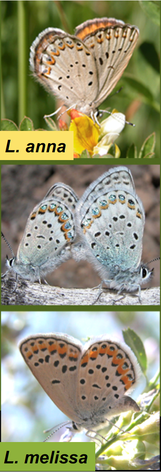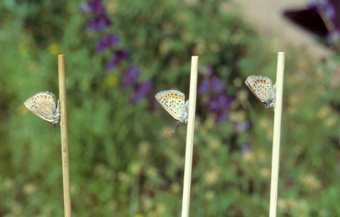|
Written by: Elizabeth Z. Dabek, MS student (Hooks Lab) and Zac Lamas, PhD student (Hawthorne Lab) Dr. Chris Nice, an evolutionary biologist from Texas State University, is working with a group of collaborators across the US to find clues as to how hybridization influences speciation. His work takes him to some amazing places, from coastal California to the alpines of the Sierra Nevada. In these areas he searches for a special genus of butterfly, the Lycaeides. Interspecies mating occurs within this group of related butterflies. Dr. Nice and his team search for a variety of cues to see if hybridization played a role in generating the diversity of species in this genus.  Darwin’s Finches popularized the idea of speciation through natural selection. An example of natural selection occurred with some of the finches Darwin observed. Some finches possessed a small beak trait that was more successful in the collection of food. This trait was then passed on to offspring. The success of the small seed eaters caused the smaller beaked population to become genetically different from larger seed specialist. Over enough time, and with additional barriers to gene flow between large and small seed eaters, speciation may occur through natural selection. Another driver of speciation is hybridization. Hybridization is what interests Dr. Nice, who uses Lycaeides butterflies, much like Darwin used the finches, as his model to study speciation. It is defined as the process by which parents of two genetically similar species produce viable offspring with characteristics of both parent species. The amount of contribution from each parent can differ, but the introgression of the individual loci or genomic regions can contribute to reproductive isolation and phenotypic or physical differences. Using techniques like analyzing genetic maps for genome stabilization the individual loci can be inspected for these differences. The four species that were studied include L. anna, L. idas, L. melissa, and L.m. samuells. We’ll call them Anna, Idas, Melissa, and Sam for short. Each of these butterflies inhabit a different area. There were some butterflies that were collected in specific areas of the Sierra Nevada mountains in the alpine region with mixes of Melissa and Anna. Dr. Nice found that alleles were strongly correlated on a geospatial scale across species. Some hybrids, like the one’s in Jackson Hole, are a mix of Ida and Melissa, and considered “ancient”. Ancient refers to the degree of homogeneity within the alleles. Ancient hybrids are found in unique environments separate from the parents to lessen the chance of competition and suppress any chance of stabilization in the hybrid zone.  Fig. 2.) Decoy females glued to sticks in order to observe male behavior in mating pattern preference. Fig. 2.) Decoy females glued to sticks in order to observe male behavior in mating pattern preference. Even though hybrid butterflies can live in different areas than the parents, it is very hard to tell what sets them apart. Each of the butterflies has distinctive patterns on the wings, some with smaller black spots and some with larger orange spots. Dr. Nice and his team investigated the sexual preference for size in wing spots. They glued female decoys on sticks and counted the number of males that visited these artificial females. Male preference was based on two things 1.) the spot size, and 2.) the presence or absence of dark spots. Males were most interested in decoys that matched their own species spot patterns. When males were given a choice test between a female of their own species, a distant relative or a hybrid, they selected their own. Besides inhabiting different areas and host plants, hybrids may also evolve different physiology and behavioral traits. For example, some hybrid lineages even developed a strange behavior: the lack of strong adhesive on eggs. The parental butterflies have adapted to have a sticky adhesive in order for the eggs to stay put on the host plant so the juvenile caterpillars don’t have to search for their first meal. The host plant in this alpine region loses its leaves in the fall and because the leaves blow away the young caterpillars would not be able to find the appropriate host plant come spring. In order for the eggs to drop into the soil the female butterflies lost the adhesive, and in turn, the eggs did not blow away with the leaves with the coming of fall. Chris’ work looks at the geographic distribution of the four distinct species of Lycaeides, and compared how different genetic and morphologies across this spatial distribution. Chris also examined which traits may be specific to hybrids, and allow them to thrive in novel environments. Then Chris looked at how morphometric in wing patterns has species specific responses. Chris and his team were able to find evidence of structure within lineages, the quantification of patterns of ancestry, and the stabilization of hybrid lineages was achieved. The importance of studying hybrid lineages is to gain a further understanding as to how different species are formed and the results of how evolution progresses within the natural environment. The mechanisms behind evolution haven't all been figured out yet! Elizabeth Z. Dabek is a MS student at the University of Maryland, College Park. She is interested in studying climate change and how it affects beneficial insects called parasitoids to help control insect pests. Zac Lamas worked commercially as a queen breeder before joining the Hawthorne Lab. Currently he is studying field effects of fungicides on honey bee colonies. Zac is interested in changes on the individual level can cause changes in social behavior. Further Reading:
Comments are closed.
|
Categories
All
Archives
June 2024
|
Department of Entomology
University of Maryland
4112 Plant Sciences Building
College Park, MD 20742-4454
USA
Telephone: 301.405.3911
Fax: 301.314.9290
University of Maryland
4112 Plant Sciences Building
College Park, MD 20742-4454
USA
Telephone: 301.405.3911
Fax: 301.314.9290

 RSS Feed
RSS Feed




